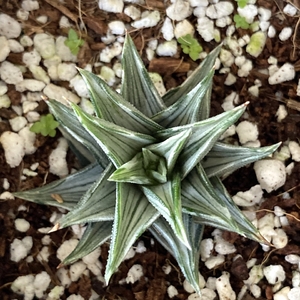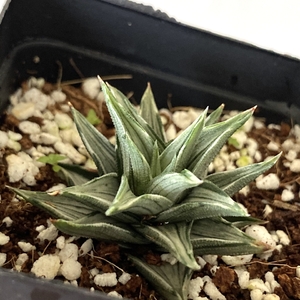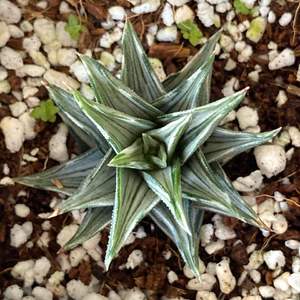植物经验
详细说明
Growing Conditions for Haworthia
Haworthias are easy to grow container and garden succulents. They are usually grown in containers as indoor plants, but you can bring them outdoors in summer.
Light
Although some species can grow in full, bright sun, most Haworthias live in more sheltered spots, and they are adapted to thrive in partial shade. In habitat, they tend to grow under bushes and rock overhangs. This adaptation makes them well suited to lower light conditions found in homes and offices. Place the potted plants in a bright area with some protection from the hottest rays of the day. White, yellow, or red-tinged leaves are usually an indicator that a Haworthia plant is receiving too much sunlight. Deep shade tends to weaken the plant over a prolonged period.
Soil
All Haworthia species do not like their roots to remain wet for prolonged periods, so their potting soil should be well-drained. In habitat, they are found growing in sandy soils in rocky areas. Use a commercial succulent soil or make your own well-draining soil mix.
Temperature
Haworthias like warmer temperatures in the summer but cool in the winter. The natural cooler temperatures found in an unheated room during the winter are perfect because they like to rest at that time of year. However, Haworthias do not like being too cold, no lower than 40 °F (4.4 °C). Some species can survive a light frost for a short period, but it is best not to take chances. Most Haworthias are cold hardy down to USDA hardiness zone 10a, 30 °F (-1.1 °C).
Pot Size
Shallow pots are generally better than deep pots, but some Haworthias have large, thick roots that ask for a deeper pot. Be sure that your container has at least one drain hole.
General Care for Haworthia
Haworthias are one of the easiest succulents to care for, which makes them popular houseplants. They are great plants for beginners.
Watering
These succulents are very tolerant of underwatering, but overwatering can quickly lead to rotting. From spring to fall, water thoroughly, then wait until the top of the soil dries out before watering again. During the winter rest period, water just enough to keep leaves from shriveling. If you use saucers, empty any standing water promptly.
Fertilizing
Haworthias are small, slow-growing succulents, and they do not require much fertilizer. For optimum growth, fertilization is a good idea. Feed only with a dilute fertilizer and only during the active growing season. Avoid summer fertilizing as Haworthias are in a short rest period. Do not fertilize newly potted plants for the first year.
Repotting
These succulents are generally slow-growing and can stay in the same pot for years. For best health, Haworthias should be repotted into fresh soil every two to three years. Many Haworthias freely offset and form clusters much larger than the individual plant. When the cluster has outgrown its pot, repot your Haworthia in the spring or early summer. Clean any dead or shriveled leaves, and move the plant into a larger pot with fresh soil mix only if the cluster covers the entire surface of the soil. Repotting time is also the time to take offsets for propagation.Light
Although some species can grow in full, bright sun, most Haworthias live in more sheltered spots, and they are adapted to thrive in partial shade. In habitat, they tend to grow under bushes and rock overhangs. This adaptation makes them well suited to lower light conditions found in homes and offices. Place the potted plants in a bright area with some protection from the hottest rays of the day. White, yellow, or red-tinged leaves are usually an indicator that a Haworthia plant is receiving too much sunlight. Deep shade tends to weaken the plant over a prolonged period.
Soil
All Haworthia species do not like their roots to remain wet for prolonged periods, so their potting soil should be well-drained. In habitat, they are found growing in sandy soils in rocky areas. Use a commercial succulent soil or make your own well-draining soil mix.
Temperature
Haworthias like warmer temperatures in the summer but cool in the winter. The natural cooler temperatures found in an unheated room during the winter are perfect because they like to rest at that time of year. However, Haworthias do not like being too cold, no lower than 40 °F (4.4 °C). Some species can survive a light frost for a short period, but it is best not to take chances. Most Haworthias are cold hardy down to USDA hardiness zone 10a, 30 °F (-1.1 °C).
Pot Size
Shallow pots are generally better than deep pots, but some Haworthias have large, thick roots that ask for a deeper pot. Be sure that your container has at least one drain hole.
General Care for Haworthia
Haworthias are one of the easiest succulents to care for, which makes them popular houseplants. They are great plants for beginners.
Watering
These succulents are very tolerant of underwatering, but overwatering can quickly lead to rotting. From spring to fall, water thoroughly, then wait until the top of the soil dries out before watering again. During the winter rest period, water just enough to keep leaves from shriveling. If you use saucers, empty any standing water promptly.
Fertilizing
Haworthias are small, slow-growing succulents, and they do not require much fertilizer. For optimum growth, fertilization is a good idea. Feed only with a dilute fertilizer and only during the active growing season. Avoid summer fertilizing as Haworthias are in a short rest period. Do not fertilize newly potted plants for the first year.
Repotting
These succulents are generally slow-growing and can stay in the same pot for years. For best health, Haworthias should be repotted into fresh soil every two to three years. Many Haworthias freely offset and form clusters much larger than the individual plant. When the cluster has outgrown its pot, repot your Haworthia in the spring or early summer. Clean any dead or shriveled leaves, and move the plant into a larger pot with fresh soil mix only if the cluster covers the entire surface of the soil. Repotting time is also the time to take offsets for propagation.
Haworthias are easy to grow container and garden succulents. They are usually grown in containers as indoor plants, but you can bring them outdoors in summer.
Light
Although some species can grow in full, bright sun, most Haworthias live in more sheltered spots, and they are adapted to thrive in partial shade. In habitat, they tend to grow under bushes and rock overhangs. This adaptation makes them well suited to lower light conditions found in homes and offices. Place the potted plants in a bright area with some protection from the hottest rays of the day. White, yellow, or red-tinged leaves are usually an indicator that a Haworthia plant is receiving too much sunlight. Deep shade tends to weaken the plant over a prolonged period.
Soil
All Haworthia species do not like their roots to remain wet for prolonged periods, so their potting soil should be well-drained. In habitat, they are found growing in sandy soils in rocky areas. Use a commercial succulent soil or make your own well-draining soil mix.
Temperature
Haworthias like warmer temperatures in the summer but cool in the winter. The natural cooler temperatures found in an unheated room during the winter are perfect because they like to rest at that time of year. However, Haworthias do not like being too cold, no lower than 40 °F (4.4 °C). Some species can survive a light frost for a short period, but it is best not to take chances. Most Haworthias are cold hardy down to USDA hardiness zone 10a, 30 °F (-1.1 °C).
Pot Size
Shallow pots are generally better than deep pots, but some Haworthias have large, thick roots that ask for a deeper pot. Be sure that your container has at least one drain hole.
General Care for Haworthia
Haworthias are one of the easiest succulents to care for, which makes them popular houseplants. They are great plants for beginners.
Watering
These succulents are very tolerant of underwatering, but overwatering can quickly lead to rotting. From spring to fall, water thoroughly, then wait until the top of the soil dries out before watering again. During the winter rest period, water just enough to keep leaves from shriveling. If you use saucers, empty any standing water promptly.
Fertilizing
Haworthias are small, slow-growing succulents, and they do not require much fertilizer. For optimum growth, fertilization is a good idea. Feed only with a dilute fertilizer and only during the active growing season. Avoid summer fertilizing as Haworthias are in a short rest period. Do not fertilize newly potted plants for the first year.
Repotting
These succulents are generally slow-growing and can stay in the same pot for years. For best health, Haworthias should be repotted into fresh soil every two to three years. Many Haworthias freely offset and form clusters much larger than the individual plant. When the cluster has outgrown its pot, repot your Haworthia in the spring or early summer. Clean any dead or shriveled leaves, and move the plant into a larger pot with fresh soil mix only if the cluster covers the entire surface of the soil. Repotting time is also the time to take offsets for propagation.Light
Although some species can grow in full, bright sun, most Haworthias live in more sheltered spots, and they are adapted to thrive in partial shade. In habitat, they tend to grow under bushes and rock overhangs. This adaptation makes them well suited to lower light conditions found in homes and offices. Place the potted plants in a bright area with some protection from the hottest rays of the day. White, yellow, or red-tinged leaves are usually an indicator that a Haworthia plant is receiving too much sunlight. Deep shade tends to weaken the plant over a prolonged period.
Soil
All Haworthia species do not like their roots to remain wet for prolonged periods, so their potting soil should be well-drained. In habitat, they are found growing in sandy soils in rocky areas. Use a commercial succulent soil or make your own well-draining soil mix.
Temperature
Haworthias like warmer temperatures in the summer but cool in the winter. The natural cooler temperatures found in an unheated room during the winter are perfect because they like to rest at that time of year. However, Haworthias do not like being too cold, no lower than 40 °F (4.4 °C). Some species can survive a light frost for a short period, but it is best not to take chances. Most Haworthias are cold hardy down to USDA hardiness zone 10a, 30 °F (-1.1 °C).
Pot Size
Shallow pots are generally better than deep pots, but some Haworthias have large, thick roots that ask for a deeper pot. Be sure that your container has at least one drain hole.
General Care for Haworthia
Haworthias are one of the easiest succulents to care for, which makes them popular houseplants. They are great plants for beginners.
Watering
These succulents are very tolerant of underwatering, but overwatering can quickly lead to rotting. From spring to fall, water thoroughly, then wait until the top of the soil dries out before watering again. During the winter rest period, water just enough to keep leaves from shriveling. If you use saucers, empty any standing water promptly.
Fertilizing
Haworthias are small, slow-growing succulents, and they do not require much fertilizer. For optimum growth, fertilization is a good idea. Feed only with a dilute fertilizer and only during the active growing season. Avoid summer fertilizing as Haworthias are in a short rest period. Do not fertilize newly potted plants for the first year.
Repotting
These succulents are generally slow-growing and can stay in the same pot for years. For best health, Haworthias should be repotted into fresh soil every two to three years. Many Haworthias freely offset and form clusters much larger than the individual plant. When the cluster has outgrown its pot, repot your Haworthia in the spring or early summer. Clean any dead or shriveled leaves, and move the plant into a larger pot with fresh soil mix only if the cluster covers the entire surface of the soil. Repotting time is also the time to take offsets for propagation.
花相册 (4)




kensong
2020年01月18日

This is my first growing diary. From AugustFame RM60.













